FROM BYZANTIUM TO ISTANBUL, Turkey

2006.04.29.
Our Middle East journey began from Istanbul on 29th of April, 2006.
Formerly known as Constantinople, the capital of the Roman, Byzantine and Ottoman Empire for over 1500 years, Istanbul is a city full of layers, where kingdoms came and go, and new buildings being built upon ruined ones. Occupying both sides of Bosporus Strait that separates Europe and Asia, Istanbul has always been a venue of cultural exchange between the east and west. The Sultanahmet area in Fatih District was the historical centre of Constantinople, where the emperors of the Roman Empire (330-395), Eastern Roman (Byzantine) Empire (395-1453) and the Ottoman Empire (1453-1923) chose to establish their splendid capital. Bounded three sides by water, the Historic Area of Istanbul is an UNESCO World Heritage site with a concentration of iconic cultural heritage that are precious to human civilization, including Hagia Sophia, Blue Mosque, Topkapi Palace, Grand Bazaar, Basilica Cistern, etc. Like many tourists, we specifically chose our hostel in Sultanahmet, just a stone throw away from the Blue Mosque. In Sultanahmet, we never needed to walk far to encounter the former glory of the empires.
 Legends has it that in 667 BC, the Greeks came to the intersection of Golden Horn, Bosphorus Strait and Marmara Sea and found the city of Byzantium at the peninsula where the current Sultanahmet area is situated.
Legends has it that in 667 BC, the Greeks came to the intersection of Golden Horn, Bosphorus Strait and Marmara Sea and found the city of Byzantium at the peninsula where the current Sultanahmet area is situated.
 Because of its strategic location at the sole access point of the Black Sea, Byzantium was soon developed into a trading city. After Emperor Constantine of the Roman Empire moved the capital from Rome to Byzantium in the 4th century, Byzantium became Constantinople, and its glorious time as Europe’s largest and wealthiest city officially kicked off.
Because of its strategic location at the sole access point of the Black Sea, Byzantium was soon developed into a trading city. After Emperor Constantine of the Roman Empire moved the capital from Rome to Byzantium in the 4th century, Byzantium became Constantinople, and its glorious time as Europe’s largest and wealthiest city officially kicked off.
 Defensive walls had been erected to protect Constantinople since Constantine’s time. Walls were also constructed along the waterfront to protect the city from sea attacks. After the partitioning of the Roman Empire, Constantinople remained as the capital of Eastern Roman Empire (Byzantine Empire).
Defensive walls had been erected to protect Constantinople since Constantine’s time. Walls were also constructed along the waterfront to protect the city from sea attacks. After the partitioning of the Roman Empire, Constantinople remained as the capital of Eastern Roman Empire (Byzantine Empire).
 In Istanbul, hundreds of underground cisterns were constructed during the Byzantine era. Measured 138m x 65m, Basilica Cistern was constructed by thousands of slaves in the 6th century under the orders of Emperor Justinian.
In Istanbul, hundreds of underground cisterns were constructed during the Byzantine era. Measured 138m x 65m, Basilica Cistern was constructed by thousands of slaves in the 6th century under the orders of Emperor Justinian.
 Probably taken from earlier Roman buildings, two stone heads of Medusa were used as column bases in Basilica Cistern. This mysterious cistern was forgotten briefly in the Middle Ages. After the Ottoman Conquest of Constantinople, local residents knew nothing about the cistern, but soon discovered that they were able to obtain water and even fish below their home basement by just lowering a bucket through a hole in the floor. The cistern was rediscovered by scholar Petrus Gyllius in 1545.
Probably taken from earlier Roman buildings, two stone heads of Medusa were used as column bases in Basilica Cistern. This mysterious cistern was forgotten briefly in the Middle Ages. After the Ottoman Conquest of Constantinople, local residents knew nothing about the cistern, but soon discovered that they were able to obtain water and even fish below their home basement by just lowering a bucket through a hole in the floor. The cistern was rediscovered by scholar Petrus Gyllius in 1545.
 The most prominent Byzantine icon is undoubtedly Hagia Sophia. Built in 537, Hagia Sophia was the largest building in the world, and housed the patriarch seat of Eastern Orthodox Church until the the 15th century.
The most prominent Byzantine icon is undoubtedly Hagia Sophia. Built in 537, Hagia Sophia was the largest building in the world, and housed the patriarch seat of Eastern Orthodox Church until the the 15th century.
 Standing opposite to Hagia Sophia is another cultural icon of Istanbul, the Sultan Ahmed Mosque or the Blue Mosque. Inspired by the Byzantine icon Hagia Sophia, the Ottomans left their mark in Constantinople more than 1000 years by constructing the Blue Mosque over the former palace complex of the Byzantine emperors.
Standing opposite to Hagia Sophia is another cultural icon of Istanbul, the Sultan Ahmed Mosque or the Blue Mosque. Inspired by the Byzantine icon Hagia Sophia, the Ottomans left their mark in Constantinople more than 1000 years by constructing the Blue Mosque over the former palace complex of the Byzantine emperors.
 Smaller in scale than the iconic monuments, Sultanahmet also host many lesser known historical buildings in the residential neighborhoods.
Smaller in scale than the iconic monuments, Sultanahmet also host many lesser known historical buildings in the residential neighborhoods.
 Walking in Sultanahmet was like going back in time, as if every other street bend was marked by splendid timber houses and pavilions from the Ottoman era.
Walking in Sultanahmet was like going back in time, as if every other street bend was marked by splendid timber houses and pavilions from the Ottoman era.
 Turkish author Orhan Pamuk’s autobiographical Istanbul: Memories and the Cities introduces readers his childhood Istanbul with a melancholic depiction of the Ottoman houses.
Turkish author Orhan Pamuk’s autobiographical Istanbul: Memories and the Cities introduces readers his childhood Istanbul with a melancholic depiction of the Ottoman houses.
 Pamuk’s writing and black and white photos showed me an unique Istanbul beyond the historical palaces, churches and mosques.
Pamuk’s writing and black and white photos showed me an unique Istanbul beyond the historical palaces, churches and mosques.
 Searching for the Ottoman houses in Istanbul was not as easy as I thought, since many had been torn down in recent years.
Searching for the Ottoman houses in Istanbul was not as easy as I thought, since many had been torn down in recent years.
 Due to continuous urban renewal in the historical centre, many Ottoman houses were at risk for redevelopment.
Due to continuous urban renewal in the historical centre, many Ottoman houses were at risk for redevelopment.
 Today, Sultanahmet has become a tourist hub, where many buildings have been converted into hotels and restaurants. In the time of commercialization, even the ruins of a 550-year bathhouse, the Ishak Pasa Hamam, is up for sale.
Today, Sultanahmet has become a tourist hub, where many buildings have been converted into hotels and restaurants. In the time of commercialization, even the ruins of a 550-year bathhouse, the Ishak Pasa Hamam, is up for sale.
 In Istanbul, we stayed at the friendly Sultan Hostel just two blocks behind the Blue Mosque.
In Istanbul, we stayed at the friendly Sultan Hostel just two blocks behind the Blue Mosque.
 At night, tourists would gather at restaurants in Sultanahmet to enjoy dinner and nargile or Turkish water pipe, along with live performance of the Sufi whirling dance.
At night, tourists would gather at restaurants in Sultanahmet to enjoy dinner and nargile or Turkish water pipe, along with live performance of the Sufi whirling dance.
KITAKARO SAPPORO HONKAN (北菓楼札幌本館), Sapporo (札幌), Hokkaido (北海道), Japan, 2019.06.24

Day 10 (3/6).
During our Hokkaido trip, we visited three works by Japanese architect Tadao Ando (安藤 忠雄): the Chapel on the Water in Tomamu, the Hill of the Buddha in Makomanai Takino Cemetery, and in Sapporo, the Kitakaro Sapporo Honkan (北菓楼札幌本館). The Japanese confectionery store is housed in the two-storey brick masonry building that was once the first library (北海道庁立図書館) and the first ever art museum in Hokkaido. Then, after being used as an archive of public records, the most recent renewal by Tadao Ando opened the building to the public once again. Ando’s team has done a great job in preserving the masonry structure and interior features of the original building such as the elegant stair at the building corner. They also created an airy atrium space with white cross vault ceiling and large bookcases on the upper level to remind visitors the building’s history as a library. Today, the lower level serves as a flagship store selling Kitakaro’s confectionery while the upper level is a popular cafe.
 The historical library building (北海道庁立図書館) is a beautiful piece of architecture dated to 1920’s.
The historical library building (北海道庁立図書館) is a beautiful piece of architecture dated to 1920’s.
 The original masonry facades are well preserved.
The original masonry facades are well preserved.
 Little contemporary touches give new life to the former library building.
Little contemporary touches give new life to the former library building.
 The main entrance of the confectionery shop, a glazed box attached to the side of the history building, presents a visual contrast to the original structure and suggests a sense of respect to the heritage building by not mingling a “fake antique” with the old.
The main entrance of the confectionery shop, a glazed box attached to the side of the history building, presents a visual contrast to the original structure and suggests a sense of respect to the heritage building by not mingling a “fake antique” with the old.
 The original stone stair is well kept. It leads visitors up to the cafe on the upper level.
The original stone stair is well kept. It leads visitors up to the cafe on the upper level.
 This stone stair has become a popular photo shooting spot for visitors.
This stone stair has become a popular photo shooting spot for visitors.
 The ground level is occupied by the confectionery store. Here visitors can appreciate the white vaulted ceiling overhead and the airy atrium.
The ground level is occupied by the confectionery store. Here visitors can appreciate the white vaulted ceiling overhead and the airy atrium.
 The red brick walls are well preserved, while the new vaulted structure is completely detached from the old masonry facade.
The red brick walls are well preserved, while the new vaulted structure is completely detached from the old masonry facade.
 From the upper level visitors can appreciate the variety of the colourful boxes of sweets available.
From the upper level visitors can appreciate the variety of the colourful boxes of sweets available.
 The interior design of the cafe is inspired by the building’s former use as a library. Bookcases are used as feature walls that stand out from the white surroundings.
The interior design of the cafe is inspired by the building’s former use as a library. Bookcases are used as feature walls that stand out from the white surroundings.
 The cafe is popular with both locals and tourists .
The cafe is popular with both locals and tourists .
 It is pleasant to dine in such an airy environment with super high ceiling.
It is pleasant to dine in such an airy environment with super high ceiling.
 Spaghetti with scallop in cream sauce. The cream sauce is surprisingly light but rich in scallop flavour. The cream sauce has the subtle sweetness of the fresh scallops.
Spaghetti with scallop in cream sauce. The cream sauce is surprisingly light but rich in scallop flavour. The cream sauce has the subtle sweetness of the fresh scallops.
 This is Kitakaro’s Special Omelet Rice. What lies underneath the layer of fresh and soft omelet is a combination of rice and Hokkaido beef. It is served with a rich sweet sauce. This dish might look simple but the combined aromatic flavor from the fresh Hokkaido ingredients is really remarkable.
This is Kitakaro’s Special Omelet Rice. What lies underneath the layer of fresh and soft omelet is a combination of rice and Hokkaido beef. It is served with a rich sweet sauce. This dish might look simple but the combined aromatic flavor from the fresh Hokkaido ingredients is really remarkable.
 The famous cream puff with smooth and silky cream that melts in the mouth, leaving behind a milky aftertaste that lingers.
The famous cream puff with smooth and silky cream that melts in the mouth, leaving behind a milky aftertaste that lingers.
 Hokkaido is famous for its lavender fields in the summer. Just like Ando’s Hill of the Buddha, lavender is used at the Kitakaro Sapporo Honkan (北菓楼札幌本館) to give some pleasant colours to the historical structure.
Hokkaido is famous for its lavender fields in the summer. Just like Ando’s Hill of the Buddha, lavender is used at the Kitakaro Sapporo Honkan (北菓楼札幌本館) to give some pleasant colours to the historical structure.
* * *
Introduction
HOKKAIDO ROAD TRIP, Hokkaido (北海道)
Day 1 – from Tokyo to Shiretoko Peninsula
Day 1.1 TSUKIJI OUTER MARKET (築地場外市場)
Day 1.2 ARRIVAL IN SHIRETOKO, Utoro (ウトロ)
Day 2 – Utoro
Day 2.1 SHIRETOKO FIVE LAKES (知床五湖)
Day 2.2 UTORO FISHERMAN’S WIVES CO-OPERATIVE DINER (ウトロ漁協婦人部食堂)
Day 2.3 FUREPE FALLS (フレペの滝)
Day 3 – Rausu
Day 3.1 RUSA FIELD HOUSE (ルサフィールドハウス)
Day 3.2 JUN NO BANYA (純の番屋)
Day 4 – Rausu
Day 4.1 MOUNT RAUSU (羅臼岳)
Day 4.2 FANTASTIC ORCAS, Nemuro Strait (根室海峡)
Day 5 – Lake Mashu & Lake Akan
Day 5.1 SUNRISE AT LAKE MASHU (摩周湖)
Day 5.2 MOUNT MASHU TRAIL (摩周岳) , Teshikaga (弟子屈)
Day 5.3 SILENT NIGHT AT LAKE AKAN (阿寒湖)
Day 6 – On the road from Lake Akan to Furano
Day 6.1 FISHERMEN BELOW MISTY OAKAN (雄阿寒岳), Lake Akan (阿寒湖)
Day 6.2 TREATS OF OBIHIRO (帯広), Tokachi (十勝)
Day 6.3 ARRIVING IN FURANO (富良野)
Day 7 Furano & Biei
Day 7.1 LAVENDER BUDS, Nakafurano (中富良野)
Day 7.2 FARM TOMITA (ファーム富田), Nakafurano (中富良野)
Day 7.3 BI.BLE, Biei (美瑛)
Day 7.4 PATCHWORK ROAD & PANORAMA ROAD, Biei (美瑛)
Day 7.5 NINGLE TERRACE (ニングルテラス)
Day 8 – from Furano to Otaru
Day 8.1 CHURCH ON THE WATER (水の教会), Hoshino Resorts Tomamu (星野リゾート トマム)
Day 8.2 HILL OF THE BUDDHA (頭大仏), Makomanai Takino Cemetery (真駒内滝野霊園)
Day 8.3 SEAFOOD, CANAL, & HISTORY, Otaru (小樽)
Day 8.4 RAINY NIGHT IN OTARU, Otaru (小樽)
Day 9 – Yochi & Sapporo
Day 9.1 NIKKA YOICHI DISTILLERY (余市蒸溜所), Yoichi (余市)
Day 9.2 SOUP CURRY NIGHT
Day 10 – Sapporo
10.1 OKKAIDO SHRINE (北海道神宮 )
10.2 MORIHICO COFFEE (森彦珈琲本店)
10.3 KITAKARO SAPPORO HONKAN (北菓楼札幌本館)
10.4 SATURDAYS CHOCOLATE
10.5 GOTSUBO OYSTER BAR(五坪)
10.6 MOUNT MOIWA (藻岩山) & RAMEN HARUKA (ラーメン悠)
Day 11 – Sapporo
11.1 FORMER HOKKAIDO GOVERNMENT OFFICE (北海道庁旧本庁舎)
11.2 RED STAR & GENGKIS KHAN, Sapporo Beer Museum (サッポロビール株式会社)
HILL OF THE BUDDHA (頭大仏), Makomanai Takino Cemetery (真駒内滝野霊園), Hokkaido (北海道), Japan, 2019.06.22

Day 8 (2/4).
The fun part of being an architect is that one could never predict what the next project would be until the client knocks on the door. For Tadao Ando, while he completed his iconic Chapel on the Water in the late 1980s, he might never imagine that over two decades later he would get a chance to realize a Buddhist shrine that houses a 13.5m statue of Buddha in Hokkaido. Situated in Makomanai Takino Cemetery (真駒内滝野霊園), Ando’s take this time on creating a spiritual encounter with the Buddha image is consisted of an artificial mount planted with 150000 lavender plants and a large oculus over the Buddha’s head. From parking lot entry to the statue, the diversity of spatial experience allow visitors to cleanse their heart before reaching the Buddha, while the concrete finishes of the architecture offer a neutral environment for lights, shadows and rain to define a spiritual atmosphere for the shrine.
 Before reaching Ando’s Buddha, we had a strange encounter with a row of what looked like to be replicas of the Moai statues in Easter island.
Before reaching Ando’s Buddha, we had a strange encounter with a row of what looked like to be replicas of the Moai statues in Easter island.
 The forecourt is dominated by a water feature where visitors must walk around in order to enter the shrine.
The forecourt is dominated by a water feature where visitors must walk around in order to enter the shrine.
 it was windy and rainy and we quickly walked around the water feature.
it was windy and rainy and we quickly walked around the water feature.
 Because of the wind and rain, we only had a quick look at the fine details of the water feature design.
Because of the wind and rain, we only had a quick look at the fine details of the water feature design.
 An cool looking passageway then led us directly into the shrine.
An cool looking passageway then led us directly into the shrine.
 At last, we arrived at the 13.5m Buddha statue.
At last, we arrived at the 13.5m Buddha statue.
 We decided to walk around the circular shrine to check out all sides of the Buddha, as well as the smaller shrines at the circumference.
We decided to walk around the circular shrine to check out all sides of the Buddha, as well as the smaller shrines at the circumference.
 The statue is slightly higher than the egg like structure, and the head of the Buddha actually sticks out.
The statue is slightly higher than the egg like structure, and the head of the Buddha actually sticks out.
 The surrounding wall panels are tilted inwards, allowing visitors to stay dry when walking around the statue even in the rain.
The surrounding wall panels are tilted inwards, allowing visitors to stay dry when walking around the statue even in the rain.
 No matter at what angle, the Buddha and the concrete structure look in perfect harmony. The rippled concrete structure also makes the shrine to appear in a solemn and contemporary ambience.
No matter at what angle, the Buddha and the concrete structure look in perfect harmony. The rippled concrete structure also makes the shrine to appear in a solemn and contemporary ambience.
 Everything is in gradients of grey, except the offering flowers.
Everything is in gradients of grey, except the offering flowers.
 Most people would walk to the front of the statue to pay their respect, say their prayers and leave some coins for offerings.
Most people would walk to the front of the statue to pay their respect, say their prayers and leave some coins for offerings.
 Looking back out towards the entrance, the passageway appeared like a tunnel out of a science fiction movie.
Looking back out towards the entrance, the passageway appeared like a tunnel out of a science fiction movie.
 Similar to the concrete structure in the shrine, the ceiling structure of the passageway also has a series of ripped vaults. Above the passageway is the mount planted with 150000 lavender plants.
Similar to the concrete structure in the shrine, the ceiling structure of the passageway also has a series of ripped vaults. Above the passageway is the mount planted with 150000 lavender plants.
 In August, the Hill of the Buddha will be filled with the fragrance of lavender.
In August, the Hill of the Buddha will be filled with the fragrance of lavender.
 Before we left, we checked out a small display adjacent to the forecourt of water feature of Ando’s drawings, sketches and photos of the construction. For architecture lovers, the detour to the Hill of Buddha is well worth the time and effort.
Before we left, we checked out a small display adjacent to the forecourt of water feature of Ando’s drawings, sketches and photos of the construction. For architecture lovers, the detour to the Hill of Buddha is well worth the time and effort.
* * *
Introduction
HOKKAIDO ROAD TRIP, Hokkaido (北海道)
Day 1 – from Tokyo to Shiretoko Peninsula
Day 1.1 TSUKIJI OUTER MARKET (築地場外市場)
Day 1.2 ARRIVAL IN SHIRETOKO, Utoro (ウトロ)
Day 2 – Utoro
Day 2.1 SHIRETOKO FIVE LAKES (知床五湖)
Day 2.2 UTORO FISHERMAN’S WIVES CO-OPERATIVE DINER (ウトロ漁協婦人部食堂)
Day 2.3 FUREPE FALLS (フレペの滝)
Day 3 – Rausu
Day 3.1 RUSA FIELD HOUSE (ルサフィールドハウス)
Day 3.2 JUN NO BANYA (純の番屋)
Day 4 – Rausu
Day 4.1 MOUNT RAUSU (羅臼岳)
Day 4.2 FANTASTIC ORCAS, Nemuro Strait (根室海峡)
Day 5 – Lake Mashu & Lake Akan
Day 5.1 SUNRISE AT LAKE MASHU (摩周湖)
Day 5.2 MOUNT MASHU TRAIL (摩周岳) , Teshikaga (弟子屈)
Day 5.3 SILENT NIGHT AT LAKE AKAN (阿寒湖)
Day 6 – On the road from Lake Akan to Furano
Day 6.1 FISHERMEN BELOW MISTY OAKAN (雄阿寒岳), Lake Akan (阿寒湖)
Day 6.2 TREATS OF OBIHIRO (帯広), Tokachi (十勝)
Day 6.3 ARRIVING IN FURANO (富良野)
Day 7 Furano & Biei
Day 7.1 LAVENDER BUDS, Nakafurano (中富良野)
Day 7.2 FARM TOMITA (ファーム富田), Nakafurano (中富良野)
Day 7.3 BI.BLE, Biei (美瑛)
Day 7.4 PATCHWORK ROAD & PANORAMA ROAD, Biei (美瑛)
Day 7.5 NINGLE TERRACE (ニングルテラス)
Day 8 – from Furano to Otaru
Day 8.1 CHURCH ON THE WATER (水の教会), Hoshino Resorts Tomamu (星野リゾート トマム)
Day 8.2 HILL OF THE BUDDHA (頭大仏), Makomanai Takino Cemetery (真駒内滝野霊園)
Day 8.3 SEAFOOD, CANAL, & HISTORY, Otaru (小樽)
Day 8.4 RAINY NIGHT IN OTARU, Otaru (小樽)
Day 9 – Yochi & Sapporo
Day 9.1 NIKKA YOICHI DISTILLERY (余市蒸溜所), Yoichi (余市)
Day 9.2 SOUP CURRY NIGHT
Day 10 – Sapporo
10.1 OKKAIDO SHRINE (北海道神宮 )
10.2 MORIHICO COFFEE (森彦珈琲本店)
10.3 KITAKARO SAPPORO HONKAN (北菓楼札幌本館)
10.4 SATURDAYS CHOCOLATE
10.5 GOTSUBO OYSTER BAR(五坪)
10.6 MOUNT MOIWA (藻岩山) & RAMEN HARUKA (ラーメン悠)
Day 11 – Sapporo
11.1 FORMER HOKKAIDO GOVERNMENT OFFICE (北海道庁旧本庁舎)
11.2 RED STAR & GENGKIS KHAN, Sapporo Beer Museum (サッポロビール株式会社)
CHURCH ON THE WATER (水の教会), Hoshino Resorts Tomamu (星野リゾート トマム), Hokkaido (北海道), Japan, 2019.06.22

Day 8 (1/4).
Many people acknowledge the harmonic relationship between buildings and nature in Japanese architecture. Taking the site’s natural context as design inspirations and the dominating factor for spatial arrangement is popular among modern Japanese architecture, where buildings are sometimes configured according to the site terrain or to a unique relationship with a natural element such as a feature tree or a water body. This respect to nature is quite apparent in the works of Tadao Ando.
On our way to Furano, we tried visiting Ando’s Chapel on the Water but failed to get in because of a private wedding taking place. We decided to return once again when we left Furano. To ensure entry, we managed to arrive at the official time for visit: 06:30 to 07:15. Getting to the chapel in Hoshino Resorts Tomamu (星野リゾート トマム) at 06:30 meaning we had to leave our hotel in Nakafurano at 5am.
 We made it to Hoshino Resorts Tomamu (星野リゾート トマム) on time for the 6:30 visiting time slot for Ando’s Chapel on the Water.
We made it to Hoshino Resorts Tomamu (星野リゾート トマム) on time for the 6:30 visiting time slot for Ando’s Chapel on the Water.
 We were surprised to find that at least 30 people were already waiting for the staff in the waiting lobby. We were soon led out to a path leading to the concrete enclosure of the chapel.
We were surprised to find that at least 30 people were already waiting for the staff in the waiting lobby. We were soon led out to a path leading to the concrete enclosure of the chapel.
 We walked along the concrete wall of the chapel until reaching an opening into the inner court.
We walked along the concrete wall of the chapel until reaching an opening into the inner court.
 Once we got into the inner court, we finally had our first glimpse of the beautiful chapel architecture and its famous cross in the water.
Once we got into the inner court, we finally had our first glimpse of the beautiful chapel architecture and its famous cross in the water.
 The entry path continued to the back corner of the chapel, where a flight of stairs led us up to the small semi enclosed platform dominated by the cross concrete members.
The entry path continued to the back corner of the chapel, where a flight of stairs led us up to the small semi enclosed platform dominated by the cross concrete members.
 From the platform we followed a spiral staircase descending down to the main chapel space.
From the platform we followed a spiral staircase descending down to the main chapel space.
 Used for wedding ceremonies, the chapel is simple and elegant. The prime focus for all visitors is the view of the cross and water pond, which takes the place of the traditional altar piece.
Used for wedding ceremonies, the chapel is simple and elegant. The prime focus for all visitors is the view of the cross and water pond, which takes the place of the traditional altar piece.
 The enormous opening can be shut with the hydraulic powered sliding door.
The enormous opening can be shut with the hydraulic powered sliding door.
 Once the door is shut, the sound of the moving water would be shut off from the interior.
Once the door is shut, the sound of the moving water would be shut off from the interior.
 The staff demonstrated the closing and opening of the sliding door for us.
The staff demonstrated the closing and opening of the sliding door for us.
 Once the door was opened, the interior was filled with the sound of moving water again.
Once the door was opened, the interior was filled with the sound of moving water again.
 The exterior scenery was peaceful and calming. The boundary between the interior and exterior didn’t seem to exist.
The exterior scenery was peaceful and calming. The boundary between the interior and exterior didn’t seem to exist.
 We could sit there for a long time just to take in the peaceful scenery and calming sound of water and birds. We could imagine how the scenery might change in different seasons.
We could sit there for a long time just to take in the peaceful scenery and calming sound of water and birds. We could imagine how the scenery might change in different seasons.
 To exit, we followed the spiral staircase to the lower level, passed through a circular space and left the building from its side.
To exit, we followed the spiral staircase to the lower level, passed through a circular space and left the building from its side.
 Outside the building, we could see the frame structure housing the track for the sliding door.
Outside the building, we could see the frame structure housing the track for the sliding door.
 Just like the Church of Light, visiting an early work of Tadao Ando is always touching and inspiring. Taking the effects of light, reflections, sounds and water to formulate the spatial qualities of the architecture, seeing his buildings has always been a spiritual experience for us.
Just like the Church of Light, visiting an early work of Tadao Ando is always touching and inspiring. Taking the effects of light, reflections, sounds and water to formulate the spatial qualities of the architecture, seeing his buildings has always been a spiritual experience for us.
* * *
Introduction
HOKKAIDO ROAD TRIP, Hokkaido (北海道)
Day 1 – from Tokyo to Shiretoko Peninsula
Day 1.1 TSUKIJI OUTER MARKET (築地場外市場)
Day 1.2 ARRIVAL IN SHIRETOKO, Utoro (ウトロ)
Day 2 – Utoro
Day 2.1 SHIRETOKO FIVE LAKES (知床五湖)
Day 2.2 UTORO FISHERMAN’S WIVES CO-OPERATIVE DINER (ウトロ漁協婦人部食堂)
Day 2.3 FUREPE FALLS (フレペの滝)
Day 3 – Rausu
Day 3.1 RUSA FIELD HOUSE (ルサフィールドハウス)
Day 3.2 JUN NO BANYA (純の番屋)
Day 4 – Rausu
Day 4.1 MOUNT RAUSU (羅臼岳)
Day 4.2 FANTASTIC ORCAS, Nemuro Strait (根室海峡)
Day 5 – Lake Mashu & Lake Akan
Day 5.1 SUNRISE AT LAKE MASHU (摩周湖)
Day 5.2 MOUNT MASHU TRAIL (摩周岳) , Teshikaga (弟子屈)
Day 5.3 SILENT NIGHT AT LAKE AKAN (阿寒湖)
Day 6 – On the road from Lake Akan to Furano
Day 6.1 FISHERMEN BELOW MISTY OAKAN (雄阿寒岳), Lake Akan (阿寒湖)
Day 6.2 TREATS OF OBIHIRO (帯広), Tokachi (十勝)
Day 6.3 ARRIVING IN FURANO (富良野)
Day 7 Furano & Biei
Day 7.1 LAVENDER BUDS, Nakafurano (中富良野)
Day 7.2 FARM TOMITA (ファーム富田), Nakafurano (中富良野)
Day 7.3 BI.BLE, Biei (美瑛)
Day 7.4 PATCHWORK ROAD & PANORAMA ROAD, Biei (美瑛)
Day 7.5 NINGLE TERRACE (ニングルテラス)
Day 8 – from Furano to Otaru
Day 8.1 CHURCH ON THE WATER (水の教会), Hoshino Resorts Tomamu (星野リゾート トマム)
Day 8.2 HILL OF THE BUDDHA (頭大仏), Makomanai Takino Cemetery (真駒内滝野霊園)
Day 8.3 SEAFOOD, CANAL, & HISTORY, Otaru (小樽)
Day 8.4 RAINY NIGHT IN OTARU, Otaru (小樽)
Day 9 – Yochi & Sapporo
Day 9.1 NIKKA YOICHI DISTILLERY (余市蒸溜所), Yoichi (余市)
Day 9.2 SOUP CURRY NIGHT
Day 10 – Sapporo
10.1 OKKAIDO SHRINE (北海道神宮 )
10.2 MORIHICO COFFEE (森彦珈琲本店)
10.3 KITAKARO SAPPORO HONKAN (北菓楼札幌本館)
10.4 SATURDAYS CHOCOLATE
10.5 GOTSUBO OYSTER BAR(五坪)
10.6 MOUNT MOIWA (藻岩山) & RAMEN HARUKA (ラーメン悠)
Day 11 – Sapporo
11.1 FORMER HOKKAIDO GOVERNMENT OFFICE (北海道庁旧本庁舎)
11.2 RED STAR & GENGKIS KHAN, Sapporo Beer Museum (サッポロビール株式会社)
BI.BLE, Biei (美瑛), Hokkaido (北海道), Japan, 2019.06.21

Day 7 (3/5).
Driving north from Farm Tomita in Nakafurano (中富良野) brought us to Biei (美瑛町) in half an hour. We followed the GPS to look for Bi.Ble, a French restaurant that caught our attention while we researched for the trip. Recommended by a guidebook, we were attracted by Bi.Ble’s dishes made from local ingredients, its pleasant timber interiors, and its picturesque setting surrounded by wheat fields. The entire compound is consisted of four buildings: a culinary school and a staff/student dormitory occupying two former school buildings, a new one-storey hotel and a new restaurant facing a wheat field. With the aid from GPS and Google Map, we didn’t have trouble finding the place and arrived at Bi.Ble at around 11:30am. We didn’t make a reservation, and were lucky to get the last table available. Other than the seafood of Shiretoko, dining at Bi.Ble to sample some of the best ingredients from Furano and Biei turned out to be one of the most remarkable meals we had throughout the trip.
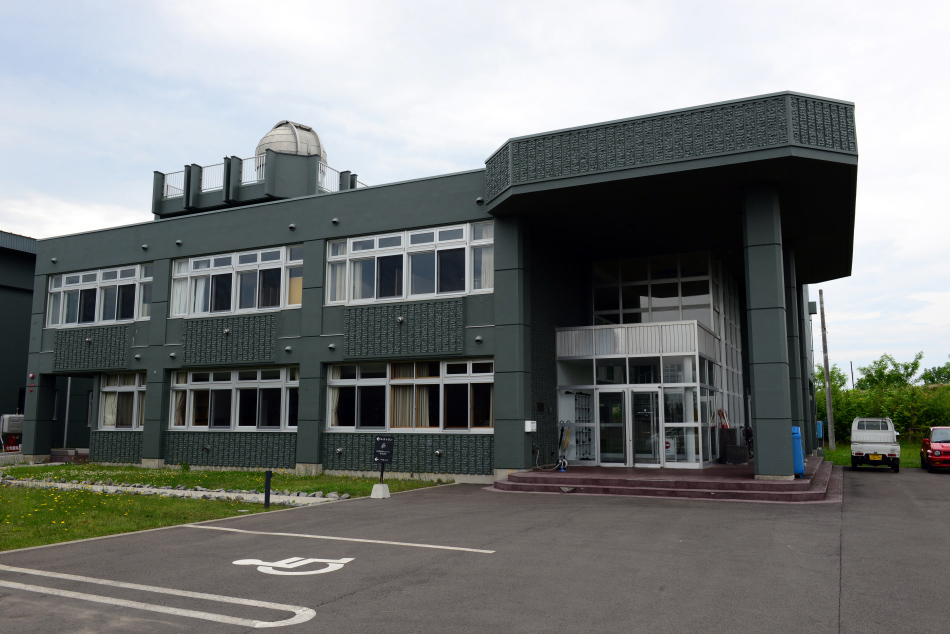 Occupying the former Hokuei Elementary School, the Ecole Hoteliere Etude is a culinary school affiliated with Bi.Ble Restaurant.
Occupying the former Hokuei Elementary School, the Ecole Hoteliere Etude is a culinary school affiliated with Bi.Ble Restaurant.
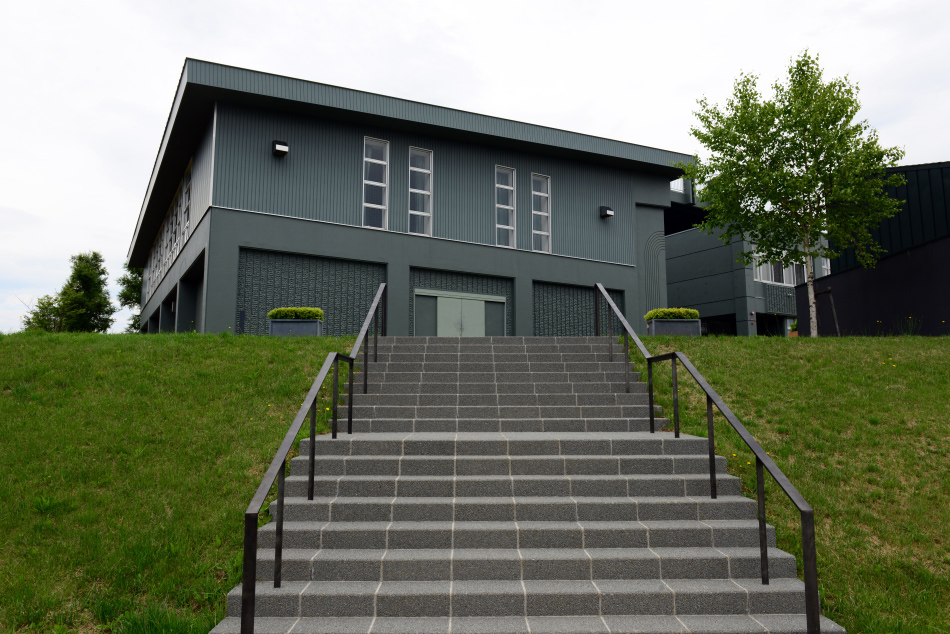 It is green everywhere in Biei, even the school building.
It is green everywhere in Biei, even the school building.
 Across from the school building stands a minimalist building cladded with green metal panels. This new addition to the school complex serves as a hotel with several guestrooms facing the wheat field.
Across from the school building stands a minimalist building cladded with green metal panels. This new addition to the school complex serves as a hotel with several guestrooms facing the wheat field.
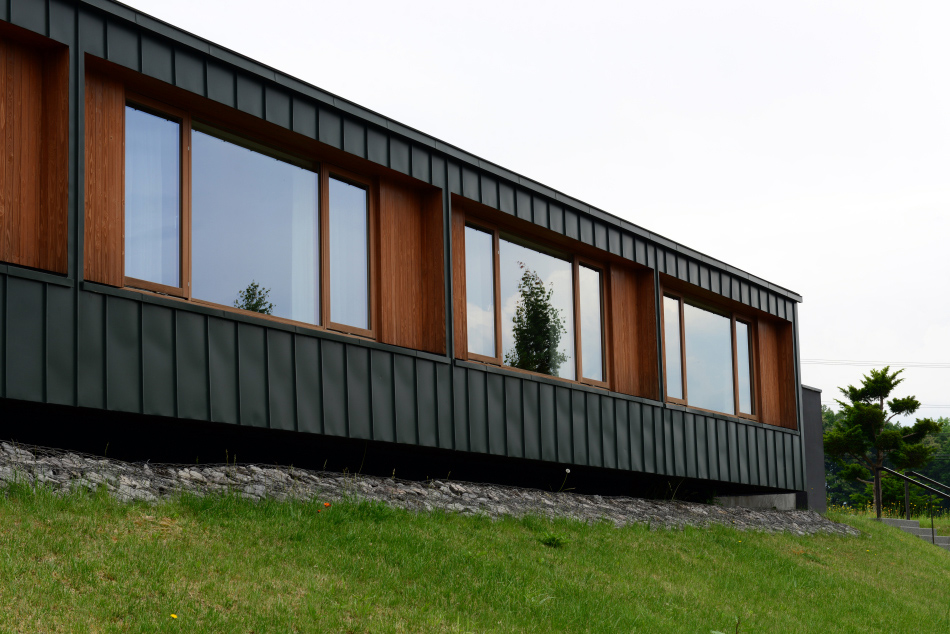 Each hotel room has a decent window.
Each hotel room has a decent window.
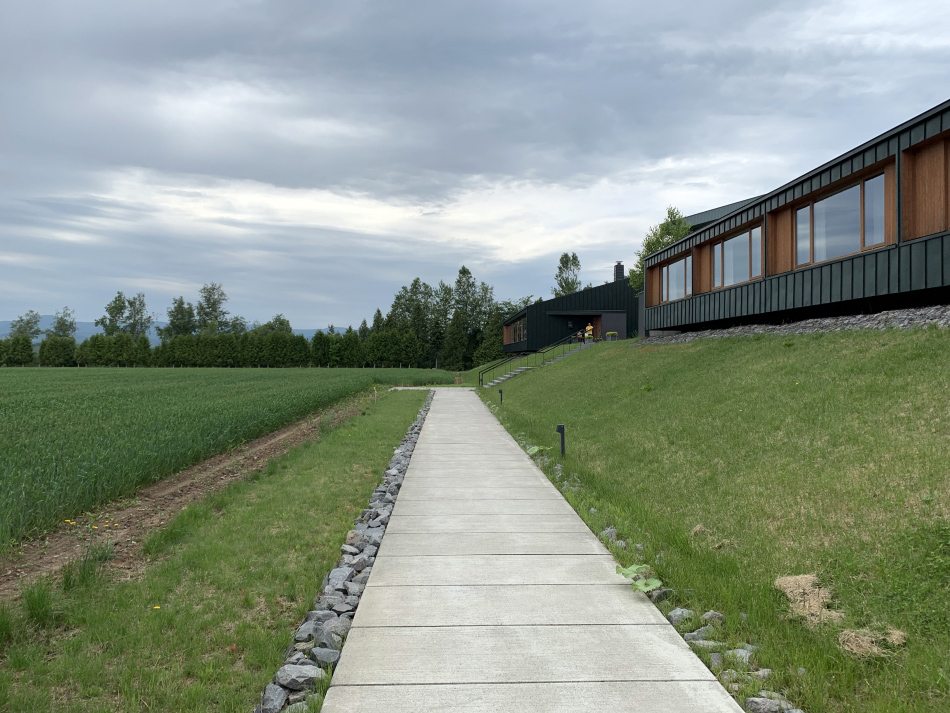 Each room enjoys the view of the picturesque wheat field below.
Each room enjoys the view of the picturesque wheat field below.
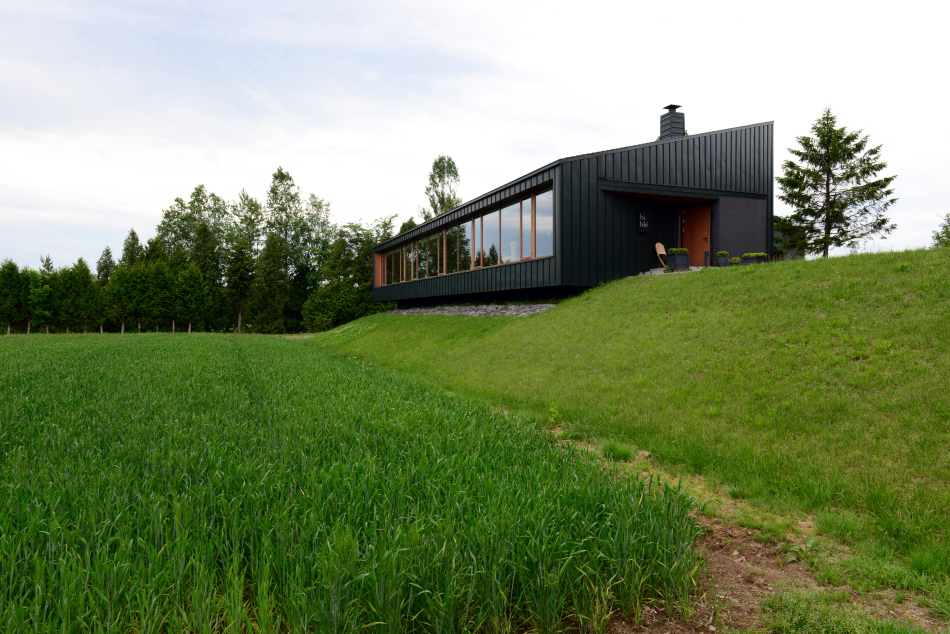 Bi.Ble Restaurant is located at the far end of the compound.
Bi.Ble Restaurant is located at the far end of the compound.
 Biei is well known for its high quality wheat and flour. In July, the wheat would turn yellow. By August, the wheat would be ready for harvest.
Biei is well known for its high quality wheat and flour. In July, the wheat would turn yellow. By August, the wheat would be ready for harvest.
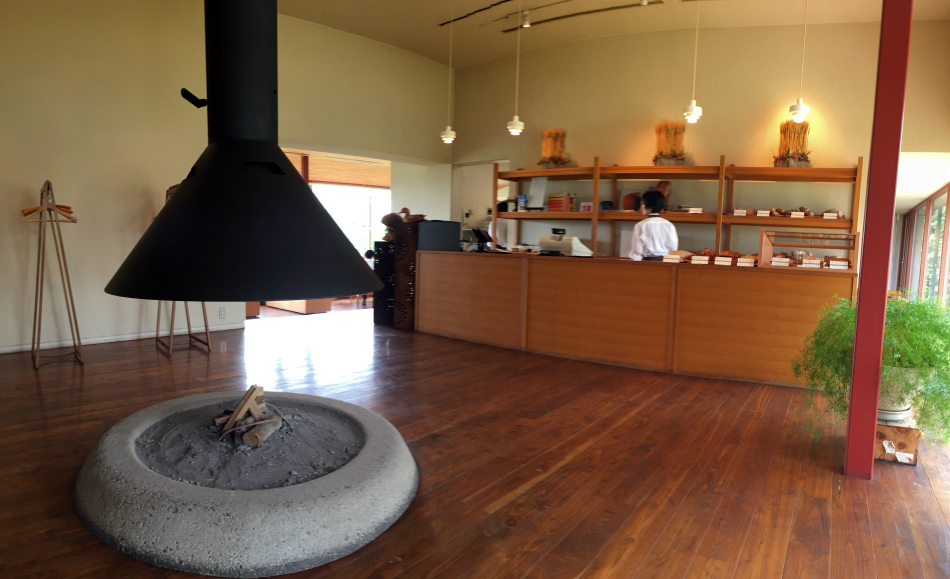 The first things that greeted our arrival at Bi.Ble was the famous bakery and its fireplace.
The first things that greeted our arrival at Bi.Ble was the famous bakery and its fireplace.
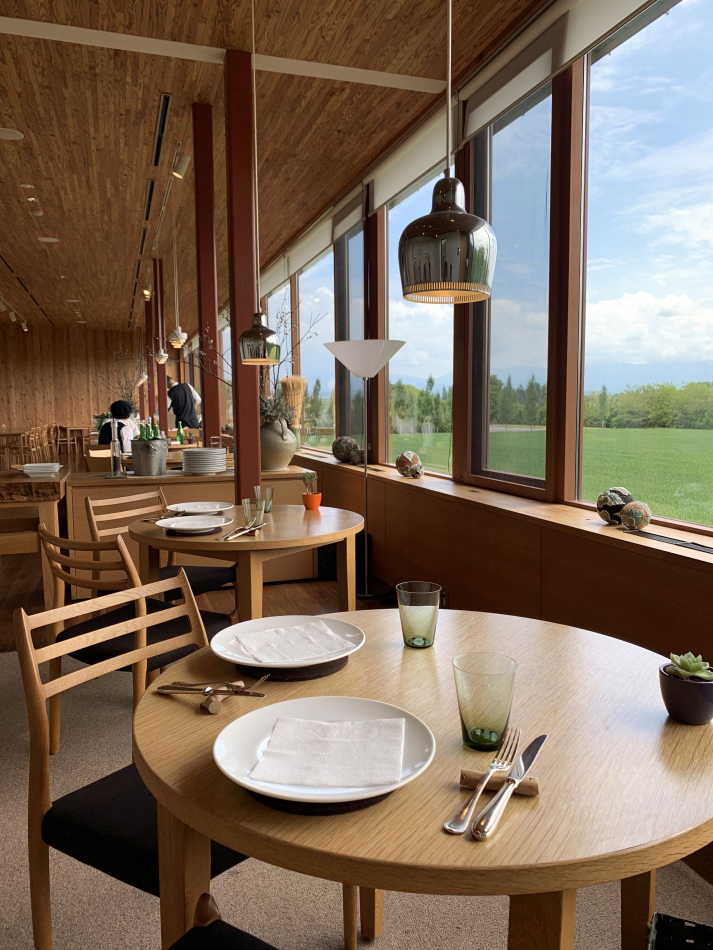 Almost all tables in the restaurant had been reserved. Came without booking, we arrived just in time to sit down at the last available table facing the wheat field.
Almost all tables in the restaurant had been reserved. Came without booking, we arrived just in time to sit down at the last available table facing the wheat field.
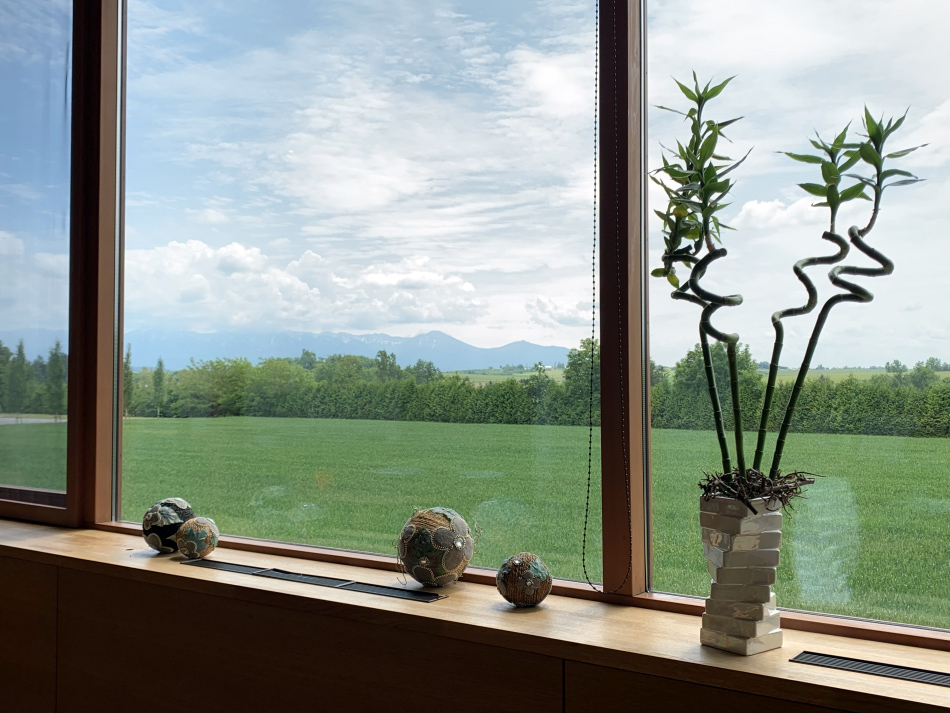 Beyond the wheat field lies the distant volcanic mountain ranges of Daisetsuzan and Tokachi, whose ashes produce the highly fertile soil of the area.
Beyond the wheat field lies the distant volcanic mountain ranges of Daisetsuzan and Tokachi, whose ashes produce the highly fertile soil of the area.
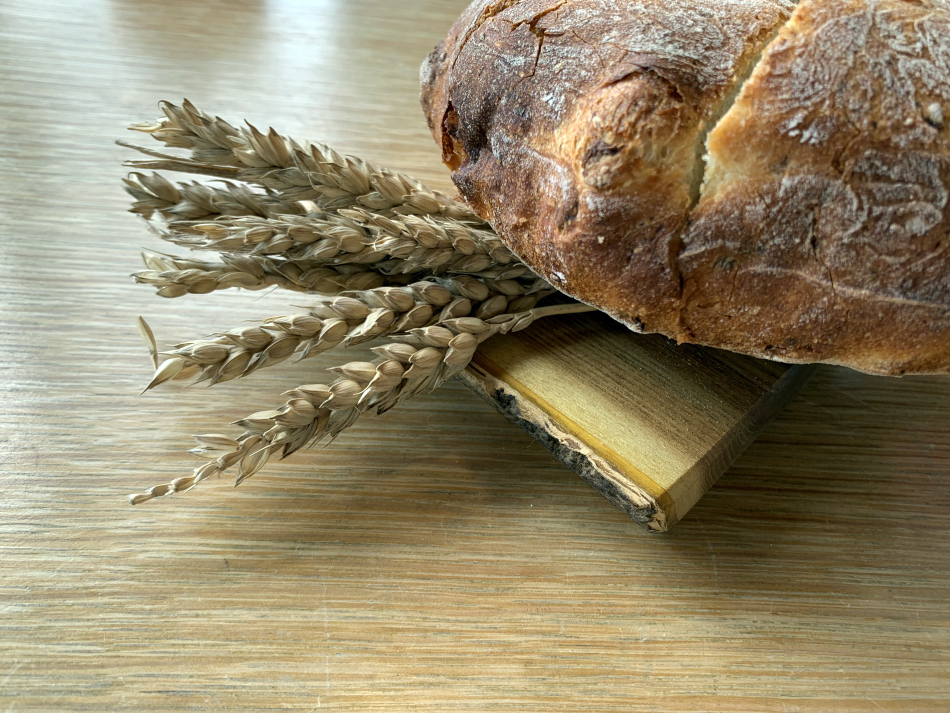 Perhaps the easiest way to appreciate the taste of Biei is to sample the simplest and purest ingredient of all, freshly baked bread made from the wheat of Biei.
Perhaps the easiest way to appreciate the taste of Biei is to sample the simplest and purest ingredient of all, freshly baked bread made from the wheat of Biei.
 Appetizers made with local pork and produces decorated with a touch of nature.
Appetizers made with local pork and produces decorated with a touch of nature.
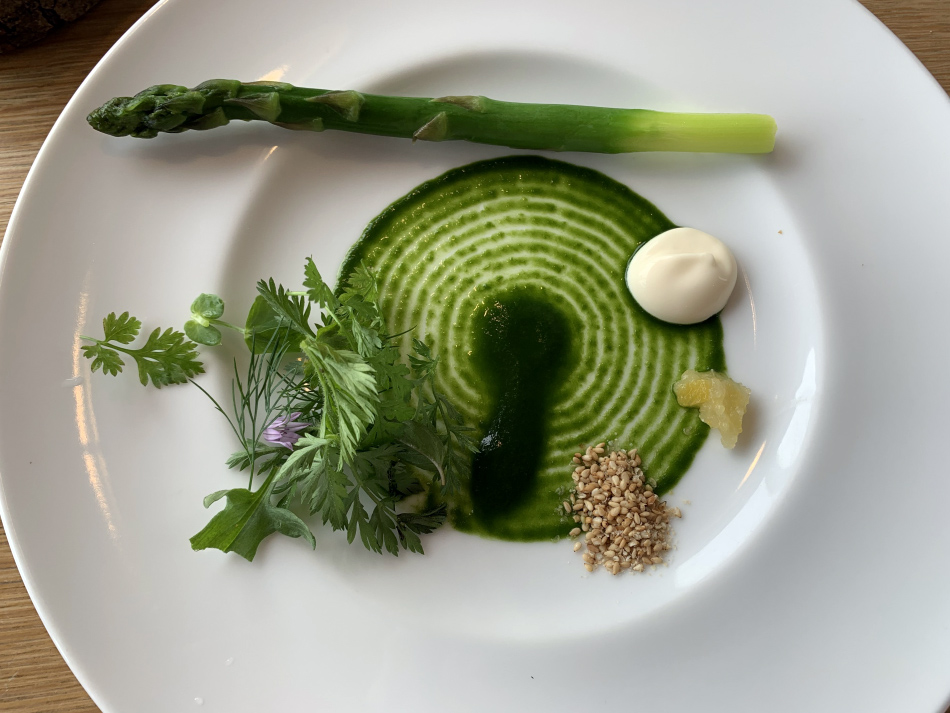 The dining experience at Bi.Ble was a fusion of French culinary techniques and Japanese aesthetics with the palette of Hokkaido.
The dining experience at Bi.Ble was a fusion of French culinary techniques and Japanese aesthetics with the palette of Hokkaido.
 From the local volcanic soil, even the most ordinary ingredients like carrot and potato tasted better.
From the local volcanic soil, even the most ordinary ingredients like carrot and potato tasted better.
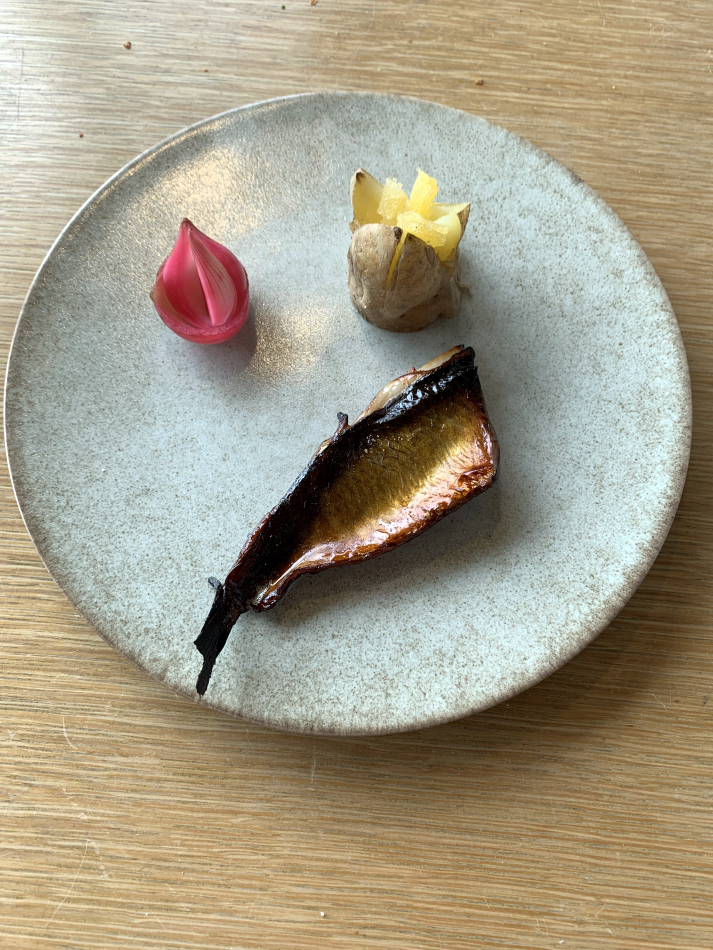 Each dish was like a minimalist painting to us.
Each dish was like a minimalist painting to us.
 Each dish came in small portions, but it ended up quite a filling meal after all the courses.
Each dish came in small portions, but it ended up quite a filling meal after all the courses.
 A fine dessert to ended a special meal.
A fine dessert to ended a special meal.
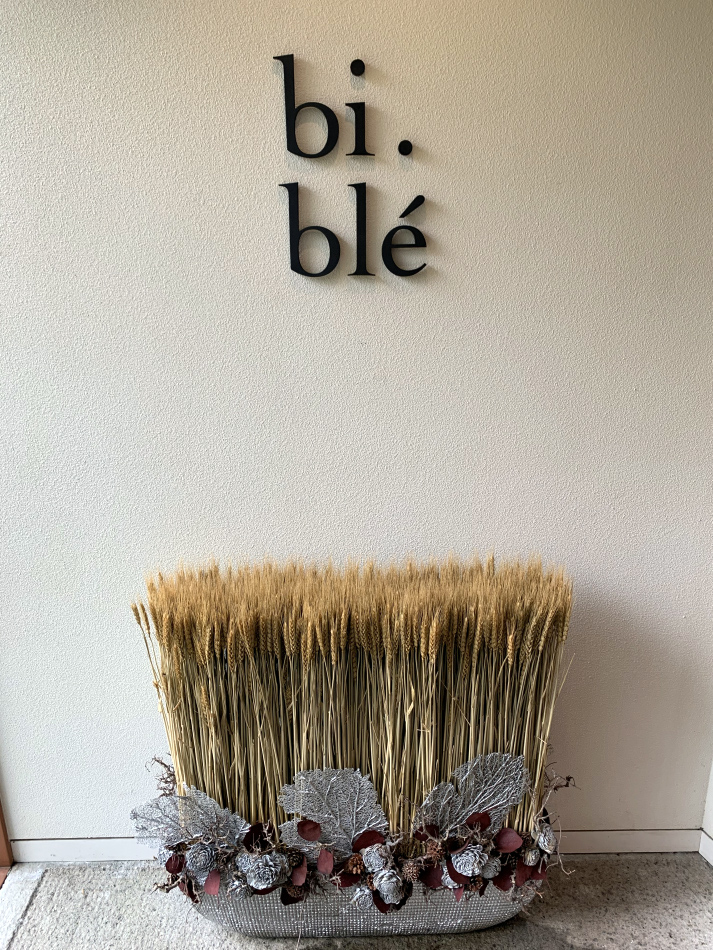 After visiting the lavender farms and floral fields of Furano, Bi.ble has given us another brilliant way to appreciate what the unique landscape of Central Hokkaido has to offer.
After visiting the lavender farms and floral fields of Furano, Bi.ble has given us another brilliant way to appreciate what the unique landscape of Central Hokkaido has to offer.
* * *
Introduction
HOKKAIDO ROAD TRIP, Hokkaido (北海道)
Day 1 – from Tokyo to Shiretoko Peninsula
Day 1.1 TSUKIJI OUTER MARKET (築地場外市場)
Day 1.2 ARRIVAL IN SHIRETOKO, Utoro (ウトロ)
Day 2 – Utoro
Day 2.1 SHIRETOKO FIVE LAKES (知床五湖)
Day 2.2 UTORO FISHERMAN’S WIVES CO-OPERATIVE DINER (ウトロ漁協婦人部食堂)
Day 2.3 FUREPE FALLS (フレペの滝)
Day 3 – Rausu
Day 3.1 RUSA FIELD HOUSE (ルサフィールドハウス)
Day 3.2 JUN NO BANYA (純の番屋)
Day 4 – Rausu
Day 4.1 MOUNT RAUSU (羅臼岳)
Day 4.2 FANTASTIC ORCAS, Nemuro Strait (根室海峡)
Day 5 – Lake Mashu & Lake Akan
Day 5.1 SUNRISE AT LAKE MASHU (摩周湖)
Day 5.2 MOUNT MASHU TRAIL (摩周岳) , Teshikaga (弟子屈)
Day 5.3 SILENT NIGHT AT LAKE AKAN (阿寒湖)
Day 6 – On the road from Lake Akan to Furano
Day 6.1 FISHERMEN BELOW MISTY OAKAN (雄阿寒岳), Lake Akan (阿寒湖)
Day 6.2 TREATS OF OBIHIRO (帯広), Tokachi (十勝)
Day 6.3 ARRIVING IN FURANO (富良野)
Day 7 Furano & Biei
Day 7.1 LAVENDER BUDS, Nakafurano (中富良野)
Day 7.2 FARM TOMITA (ファーム富田), Nakafurano (中富良野)
Day 7.3 BI.BLE, Biei (美瑛)
Day 7.4 PATCHWORK ROAD & PANORAMA ROAD, Biei (美瑛)
Day 7.5 NINGLE TERRACE (ニングルテラス)
Day 8 – from Furano to Otaru
Day 8.1 CHURCH ON THE WATER (水の教会), Hoshino Resorts Tomamu (星野リゾート トマム)
Day 8.2 HILL OF THE BUDDHA (頭大仏), Makomanai Takino Cemetery (真駒内滝野霊園)
Day 8.3 SEAFOOD, CANAL, & HISTORY, Otaru (小樽)
Day 8.4 RAINY NIGHT IN OTARU, Otaru (小樽)
Day 9 – Yochi & Sapporo
Day 9.1 NIKKA YOICHI DISTILLERY (余市蒸溜所), Yoichi (余市)
Day 9.2 SOUP CURRY NIGHT
Day 10 – Sapporo
10.1 OKKAIDO SHRINE (北海道神宮 )
10.2 MORIHICO COFFEE (森彦珈琲本店)
10.3 KITAKARO SAPPORO HONKAN (北菓楼札幌本館)
10.4 SATURDAYS CHOCOLATE
10.5 GOTSUBO OYSTER BAR(五坪)
10.6 MOUNT MOIWA (藻岩山) & RAMEN HARUKA (ラーメン悠)
Day 11 – Sapporo
11.1 FORMER HOKKAIDO GOVERNMENT OFFICE (北海道庁旧本庁舎)
11.2 RED STAR & GENGKIS KHAN, Sapporo Beer Museum (サッポロビール株式会社)
HOKKAIDO ROAD TRIP, Hokkaido (北海道), Japan, June 15-25, 2019

Tsuyu (梅雨), the rain season, begins to hit Okinawa in May and gradually makes its way north to the rest of Japan until the end of June. During the wet season, rainy and cloudy weather affects the entire country except Hokkaido, Japan’s second largest island north of the main Honshu Island. The seismic active island is 3.6% smaller than Ireland, with a climate significantly cooler than the rest of Japan. Seeking for a pleasant getaway from Hong Kong’s humid and hot summer, we picked Hokkaido as the destination for our 11-day vacation from 15th to 25th of June. Traveling in the remote national parks and rural countryside of Hokkaido, hiring a car was a necessity. The Hokkaido journey was our first road trip in Japan.
Known as Japan’s last true wilderness, Shiretoko National Park (知床国立公園) is the natural haven where Brown Bears and Blakiston Fish Owls ruled the primeval forests and Orcas, Minke and Sperm Whales roamed the waters of Nemuro Strait. With fantastic natural scenery, wildlife and seafood to offer, this easternmost part of Hokkaido topped our priority list in the travel itinerary. Next in the journey took us to the spectacular volcanoes of Akan Mashu National Park (阿寒摩周国立公園), where we came close to Japan’s clearest water at caldera Lake Mashu (摩周湖) and the fantastic onsen and fly fishing hot spot of Lake Akan (阿寒湖). While the lavender fields of Furano (富良野) and Biei (美瑛) had yet reached the peak bloom moment, the ultra fertile soil below the Tokachi Volcanic Group (十勝火山群) treated us with some of the best bread, corn, potatoes, asparagus, melons and milk that we ever had in our lives. Despite far away from Tokyo and Osaka, the architectural magic of Tadao Ando (安藤忠雄) in Hokkaido satisfied our thirst of contemporary design and aesthetics. Back in Obihiro (帯広), Otaru (小樽) and Sapporo (札幌), historic traces of early pioneers and contemporary dessert shops and local eateries brought us back to delightful charm of urban Japan. What’s more? Day after day of mouthwatering seafood, fresh produces, good coffee, and lovely patisseries reminded us how wonderful our world could be, when the water is clean, soil is rich, forests are healthy and people are friendly. Thank you Hokkaido. You have truly touched our hearts.
 Located north of Honshu Island, Hokkaido is the second largest island in Japan.
Located north of Honshu Island, Hokkaido is the second largest island in Japan.
 Flying in from Tokyo Haneda, our Hokkaido journey began from Memanbetsu (女満別空港) near the Shiretoko Peninsula. After more than 1,181km of driving, we arrived at Otaru and Sapporo at the western side of the island.
Flying in from Tokyo Haneda, our Hokkaido journey began from Memanbetsu (女満別空港) near the Shiretoko Peninsula. After more than 1,181km of driving, we arrived at Otaru and Sapporo at the western side of the island.
 This black hatchback hybrid Toyota Prius c (Toyota Aqua in Japan) provided us the means of transport from east to west across Hokkaido.
This black hatchback hybrid Toyota Prius c (Toyota Aqua in Japan) provided us the means of transport from east to west across Hokkaido.
 After 2 days of rain and wind, we finally had a glimpse of the active volcano of Mount Rausu (羅臼岳), the tallest peak in Shiretoko Peninsula.
After 2 days of rain and wind, we finally had a glimpse of the active volcano of Mount Rausu (羅臼岳), the tallest peak in Shiretoko Peninsula.
 The greatest experience we took away from Shiretoko was the close encounter with a pod of orcas in the Nemuro Strait.
The greatest experience we took away from Shiretoko was the close encounter with a pod of orcas in the Nemuro Strait.
 The Mashu Lake (摩周湖) offered us a peaceful sunrise at 3:30am.
The Mashu Lake (摩周湖) offered us a peaceful sunrise at 3:30am.
 Under the shadow of Mount Oakan (雄阿寒岳), dozens of fly fishermen stepped into the crystal water of Lake Akan (阿寒湖) to test their luck.
Under the shadow of Mount Oakan (雄阿寒岳), dozens of fly fishermen stepped into the crystal water of Lake Akan (阿寒湖) to test their luck.
 Farms and greenhouses were washed with heavy rain as we entered into Furano (富良野).
Farms and greenhouses were washed with heavy rain as we entered into Furano (富良野).
 Still at least half a month to go before the peak season of lavender blossom, visitors were enjoying themselves at a relatively less crowded Farm Tomita in Nakafurano.
Still at least half a month to go before the peak season of lavender blossom, visitors were enjoying themselves at a relatively less crowded Farm Tomita in Nakafurano.
 Compared with rainbow flower fields, we loved the wheat fields at Biei the most.
Compared with rainbow flower fields, we loved the wheat fields at Biei the most.
 Tadao Ando’s Chapel on the Water has been famous in the designer’s world since the 1980s.
Tadao Ando’s Chapel on the Water has been famous in the designer’s world since the 1980s.
 The Hill of Buddha is the latest addition in Hokkaido by Tadao Ando.
The Hill of Buddha is the latest addition in Hokkaido by Tadao Ando.
 At Yoichi Distillery (余市蒸溜所), whiskey has been produced since 1934.
At Yoichi Distillery (余市蒸溜所), whiskey has been produced since 1934.
 Saturdays Chocolate in Sapporo is one of the many excellent local eateries and cafes that we visited in the journey.
Saturdays Chocolate in Sapporo is one of the many excellent local eateries and cafes that we visited in the journey.
 Last but not least, Hokkaido offered us the best seafood and dessert that we ever had as far as we could remember. Let’s begin to tell the story of our journey!
Last but not least, Hokkaido offered us the best seafood and dessert that we ever had as far as we could remember. Let’s begin to tell the story of our journey!
* * *
Introduction
HOKKAIDO ROAD TRIP, Hokkaido (北海道)
Day 1 – from Tokyo to Shiretoko Peninsula
Day 1.1 TSUKIJI OUTER MARKET (築地場外市場)
Day 1.2 ARRIVAL IN SHIRETOKO, Utoro (ウトロ)
Day 2 – Utoro
Day 2.1 SHIRETOKO FIVE LAKES (知床五湖)
Day 2.2 UTORO FISHERMAN’S WIVES CO-OPERATIVE DINER (ウトロ漁協婦人部食堂)
Day 2.3 FUREPE FALLS (フレペの滝)
Day 3 – Rausu
Day 3.1 RUSA FIELD HOUSE (ルサフィールドハウス)
Day 3.2 JUN NO BANYA (純の番屋)
Day 4 – Rausu
Day 4.1 MOUNT RAUSU (羅臼岳)
Day 4.2 FANTASTIC ORCAS, Nemuro Strait (根室海峡)
Day 5 – Lake Mashu & Lake Akan
Day 5.1 SUNRISE AT LAKE MASHU (摩周湖)
Day 5.2 MOUNT MASHU TRAIL (摩周岳) , Teshikaga (弟子屈)
Day 5.3 SILENT NIGHT AT LAKE AKAN (阿寒湖)
Day 6 – On the road from Lake Akan to Furano
Day 6.1 FISHERMEN BELOW MISTY OAKAN (雄阿寒岳), Lake Akan (阿寒湖)
Day 6.2 TREATS OF OBIHIRO (帯広), Tokachi (十勝)
Day 6.3 ARRIVING IN FURANO (富良野)
Day 7 Furano & Biei
Day 7.1 LAVENDER BUDS, Nakafurano (中富良野)
Day 7.2 FARM TOMITA (ファーム富田), Nakafurano (中富良野)
Day 7.3 BI.BLE, Biei (美瑛)
Day 7.4 PATCHWORK ROAD & PANORAMA ROAD, Biei (美瑛)
Day 7.5 NINGLE TERRACE (ニングルテラス)
Day 8 – from Furano to Otaru
Day 8.1 CHURCH ON THE WATER (水の教会), Hoshino Resorts Tomamu (星野リゾート トマム)
Day 8.2 HILL OF THE BUDDHA (頭大仏), Makomanai Takino Cemetery (真駒内滝野霊園)
Day 8.3 SEAFOOD, CANAL, & HISTORY, Otaru (小樽)
Day 8.4 RAINY NIGHT IN OTARU, Otaru (小樽)
Day 9 – Yochi & Sapporo
Day 9.1 NIKKA YOICHI DISTILLERY (余市蒸溜所), Yoichi (余市)
Day 9.2 SOUP CURRY NIGHT
Day 10 – Sapporo
10.1 OKKAIDO SHRINE (北海道神宮 )
10.2 MORIHICO COFFEE (森彦珈琲本店)
10.3 KITAKARO SAPPORO HONKAN (北菓楼札幌本館)
10.4 SATURDAYS CHOCOLATE
10.5 GOTSUBO OYSTER BAR(五坪)
10.6 MOUNT MOIWA (藻岩山) & RAMEN HARUKA (ラーメン悠)
Day 11 – Sapporo
11.1 FORMER HOKKAIDO GOVERNMENT OFFICE (北海道庁旧本庁舎)
11.2 RED STAR & GENGKIS KHAN, Sapporo Beer Museum (サッポロビール株式会社)
DAY 10 (2/3): HUMAYUN’S TOMB, Delhi, India, 2018.12.03

Last time when we first visited Delhi, we only had time to see the Red Fort and Jama Masjid. Similar to last time, we had a few hours of stopover time before flying back to Hong Kong. After lunch at Khan Market, we spent the day in the area of Nizamuddin, a busy Medieval neighborhood with narrow lanes and community mosques. The famous Humayun’s Tomb is the biggest draw for visitors in the area. From the closest metro station Jawaharlal Nehru Stadium, it was a ten minute walk to the enormous tomb ground. Despite the short distance, crossing the dusty roads, walking under flyovers, and finding ourselves towards the right park entrance was not as straightforward as we thought. Anyhow, we managed to arrive at a rather chaotic queuing scene at the ticket office.
Commissioned by Empress Bega Begum for her husband Mughal Emperor Humayun, Humayun’s Tomb was built in 1569-70 in Delhi’s Nizamuddin East. Designed by Persian architects Mirak Mirza Ghiyas and Sayyid Muhammad, Humayun’s Tomb was the first large scale structure made with red sandstone. Declared a UNESCO World Heritage, the splendid structure had set a fine standard for latter Mughal architecture, including the Taj Mahal.
 After obtaining the admission tickets, we entered the complex of Humayun’s Tomb through a series of gateways and courtyards.
After obtaining the admission tickets, we entered the complex of Humayun’s Tomb through a series of gateways and courtyards.
 We followed a prominent water channel towards the beautiful sandstone building of Humayun’s Tomb. Reference to Char Bagh (Four Gardens) of the Paradise in the Koran, the tomb garden is a 30-acre square carved into smaller squares by paths and water channels.
We followed a prominent water channel towards the beautiful sandstone building of Humayun’s Tomb. Reference to Char Bagh (Four Gardens) of the Paradise in the Koran, the tomb garden is a 30-acre square carved into smaller squares by paths and water channels.
 The tomb structure reaches a height of 47m, with obvious influences from Persian architecture. The entire structure sits on a large platform with a few meters high.
The tomb structure reaches a height of 47m, with obvious influences from Persian architecture. The entire structure sits on a large platform with a few meters high.
 The arch and beam structure together with the use of red sandstone, white marble, and Rajasthani decorations exemplifies the Mughal architecture lasted in India for four hundred years.
The arch and beam structure together with the use of red sandstone, white marble, and Rajasthani decorations exemplifies the Mughal architecture lasted in India for four hundred years.
 The red sandstone and white marble provide a splendid combination of facade treatments and decorations.
The red sandstone and white marble provide a splendid combination of facade treatments and decorations.
 Modeled on the Paradise Garden in Koran, the garden is divided into 36 squares by axes of water channels and paths.
Modeled on the Paradise Garden in Koran, the garden is divided into 36 squares by axes of water channels and paths.
 Just like a few other attractions, we encountered a large group of school students at Humayun’s Tombs.
Just like a few other attractions, we encountered a large group of school students at Humayun’s Tombs.
 Entrance dome of Humayun’s Tomb was decorated with elegant lines.
Entrance dome of Humayun’s Tomb was decorated with elegant lines.
 Much less crowded than the Taj Mahal, visitors could appreciate the solemn interior of the mausoleum.
Much less crowded than the Taj Mahal, visitors could appreciate the solemn interior of the mausoleum.
 The main level houses the cenotaph of Emperor Humayun and Empress Bega Begum and also several other Mughal rulers from a later period. The real graves lie one level before in the basement.
The main level houses the cenotaph of Emperor Humayun and Empress Bega Begum and also several other Mughal rulers from a later period. The real graves lie one level before in the basement.
 It’s common to see school groups when visiting historical movements in India.
It’s common to see school groups when visiting historical movements in India.
 Inspired by Persian garden, the 30 acre tomb garden is subdivided by a network of water channels.
Inspired by Persian garden, the 30 acre tomb garden is subdivided by a network of water channels.
 After visiting the interior of the tomb, we circled around the structure on the upper platform.
After visiting the interior of the tomb, we circled around the structure on the upper platform.
 We returned to the garden at the ground level via one of the four covered staircases.
We returned to the garden at the ground level via one of the four covered staircases.
 As we left the complex, the late afternoon sun cast a warm amber tone on the white marble and accentuated the reddish tone of the sandstone.
As we left the complex, the late afternoon sun cast a warm amber tone on the white marble and accentuated the reddish tone of the sandstone.
 A final view of the front facade of the building before we left the complex.
A final view of the front facade of the building before we left the complex.
 Near Humayun’s Tomb, there is another magnificent tomb architecture known as Isa Khan’s Tomb. Built in 1547 – 58, the octagonal structure is decorated with canopies, glazed tiles, lattice screens, and a prominent verandah.
Near Humayun’s Tomb, there is another magnificent tomb architecture known as Isa Khan’s Tomb. Built in 1547 – 58, the octagonal structure is decorated with canopies, glazed tiles, lattice screens, and a prominent verandah.
***
Posts on 2018 Rajasthan:-
Day 1: Jodhpur
DAY 1.1: IN TRANSIT TO RAJASTHAN
DAY 1.2: PAL HAVELI & THE OMELETTE MAN, Jodhpur
DAY 1.3: SPLENDOR OF THE SUN FORT, Mehrangarh, Jodhpur
DAY 1.4: SUNSET OVER THE BLUE CITY, Mehrangarh, Jodhpur
DAY 1.5: SADAR MARKET AND GHANTA GHAR CLOCKTOWER, Jodhpur
Day 2: Jodhpur, Osian, Jaisalmer
DAY 2.1: MARBLE CENOTAPH JASWANT THADA, Jodhpur
DAY 2.2: MEDIEVAL STEPWELLS, Mahila Bagh Ka Jhalra, Gulab Sagar, & Toorji Ka Jhalra, Jodhpur
DAY 2.3: PILGRIM OASIS IN THAR DESERT, Sachiya Mata Temple, Osian
DAY 2.4: SUNRISE AT THE FIRST GATE OF GOLDEN FORT, Jaisalmer
Day 3: Jaisalmer
DAY 3.1: THE GOLDEN LIVING FORT, Jaisalmer
DAY 3.2: JAIN TEMPLES PART 1, Jaisalmer
DAY 3.3: JAIN TEMPLES PART 2, Jaisalmer
DAY 3.4: FORT PALACE, Jaisalmer
Day 4: Jaisalmer
DAY 4.1: RESERVOIR OF THE GOLDEN CITY, Gadsisar Lake, Jaisalmer
DAY 4.2: ARCHITECTURAL JEWEL OF RAJASTHAN, Patwon Ki Haveli Part 1, Jaisalmer
DAY 4.3: ARCHITECTURAL JEWEL OF RAJASTHAN, Patwon Ki Haveli Part 2, Jaisalmer
DAY 4.4: DESERT HERITAGE, Hotel Nachana Haveli and Thar Heritage Museum, Jaisalmer
DAY 4.5: LAST STROLL IN THE GOLDEN CITY, Jaisalmer
Day 5: Pushkar
DAY 5.1: RANIKHET EXPRESS
DAY 5.2: 52 BATHING GHATS, Pushkar
DAY 5.3: SUNSET OVER SACRED WATER, Pushkar
Day 6: Pushkar & Jaipur
DAY 6.1: SUNRISE OVER PUSHKAR LAKE, Pushkar
DAY 6.2: GRANDEUR OF THE MAHARAJA, City Palace, Jaipur
DAY 6.3: IN SEARCH OF 1860 CARL ZEISS CAMERA, Jaipur
Day 7: Jaipur
DAY 7.1: AMBER FORT, Jaipur
DAY 7.2: JAIGARH FORT, Jaipur
DAY 7.3: MAHARAJA’S ASTRONOMICAL LEGACY, Jantar Mantar, Jaipur
DAY 7.4: PALACE OF WINDS, Hawa Mahal, Jaipur
Day 8: Bhangarh, Abhaneri & Agra
DAY 8.1: ON THR ROAD TO AGRA
DAY 8.2: HAUNTED RUINS, Bhangarh, Rajasthan
DAY 8.3: CHAND BAORI, Abhaneri, Rajasthan
DAY 8.4: THE ABANDONED CAPITAL OF MUGHAL EMPIRE, Fatehpur Sikri, Agra, Uttar Pradesh
DAY 8.5: FRIDAY MOSQUE, Fatehpur Sikri, Agra, Uttar Pradesh
Day 9: Agra
DAY 9.1: CROWN OF THE PALACES, Taj Mahal, Agra, Uttar Pradesh
DAY 9.2: AGRA FORT, Agra, Uttar Pradesh
DAY 9.3: RAWATPARA SPICE MARKET, Agra, Uttar Pradesh
DAY 9.4: SUNSET AT MEHTAB BAGH, Agra, Uttar Pradesh
Day 10: Delhi
DAY 10.1: TRAIN 12627, Agra to Delhi
DAY 10.2 : HUMAYUN’S TOMB, Delhi
Day 10.3: NIZAMUDDIN BASTI, Delhi
